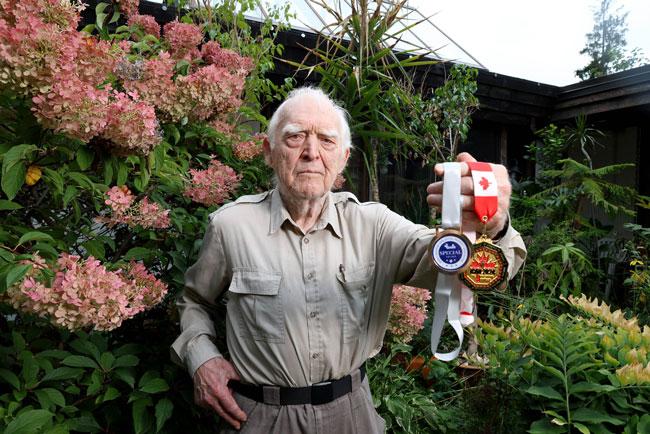November 25, 2024 | Alumni
U of T alum wins innovation award at the age of 98
By Phill Snel

Lembit Maimets.
A U of T Engineering alumnus has been awarded a very modern prize for invention and design of a space-age structure dating back to the 1970s.
Lembit Maimets (BASc 1956) earned first place with the International Special Award for his entry of Self-unfolding satellite with gravity from the World Invention Intellectual Property Association (WIIPA). Additionally, a special honour was given from the Association of Thai Innovation and Invention Promotion. The announcement came at the International Invention Innovation Competition in Canada: iCan 2024.
“It was quite a surprise – I didn’t expect it,” remarks the inventor and entrepreneur.
Long-term perseverance is somewhat of a recurring trend with Maimets – who recently turned 98 – throughout his academic and professional career. The design was conceived and patented in the 1970s.
“The patent has now expired – back in 1993 I think,” says Maimets. “When I was asked to enter something in this contest, I just remembered it and took it out to enter.”
In very simple terms, the structure he has designed is a large, hollow doughnut with an elegant and simple method for deployment in space. Maimets explains how his compact package can expand itself.
“It is something that uses the internal stresses in the material, so that when in zero gravity, the stresses are released, the structure becomes a doughnut, basically,” he says.
“And that’s it by itself. Then people get into it afterwards, do whatever they have to do to set it up so that astronauts can live in it to make a habitable structure. One of those doughnuts can accommodate about 800 people and you can stack them up. I would say that in the whole drum, maybe 10,000 people can be there. The power can be with a nuclear power system.”

One of the main benefits of the structure’s design is it could offer Earth-like gravity when spinning around its axis. This concept would allow for long-lasting space voyages, as it would enable astronauts to maintain muscle and bone density with the simulated gravity constantly in operation.
Further, stacking and connecting the structures would allow for far greater occupancy and payload as necessary for a long journey.
The Estonian-born inventor and entrepreneur had started studies in Germany after the Second World War, but found the country uninviting to outsiders. Soon after, he came to Canada in 1947.
Though he wanted to immediately return to his engineering studies, Maimets had to first find work. Putting great physical effort into his job with Ontario Hydro, Maimets earned enough to return to his studies with Civil Engineering at U of T in 1949. His return, though, was short lived.
“I failed my second year and had to work before I came back. I had no question; I had to finish – this was my goal,” says Maimets.
“I did everything I had to do – I cleaned offices at night, sold meat at a grocery store counter, set up bowling pins. Of course, I didn’t have time to sleep, so I slept in the streetcar in those days. Yeah, it was quite an interesting experience. Finally, I made it.”
After graduating, Maimets spent another 14 years (20 in total) working with municipalities in the Greater Toronto Area – ten years as a consulting engineer designing high-rise structures and over a year at National Research Council Canada on its Associate Committee on National Building Code.
Maimets founded Link-Pipe Inc. in 1980, a manufacturer of no-dig pipe repair products. As president and CEO, he has multiple patents for repairing pipes and conduits. Recently, as a move towards retirement, he closed the business on July 31 and licensed his technology to companies in the Middle East and Africa, with a view to expand licensing to Europe and Singapore.
“I have worked on all five continents except the South Pole. It has been very interesting travelling to places like Asia, Australia, New Zealand, Russia, Europe and the Middle East, of course. That’s been very interesting and excellent.”

